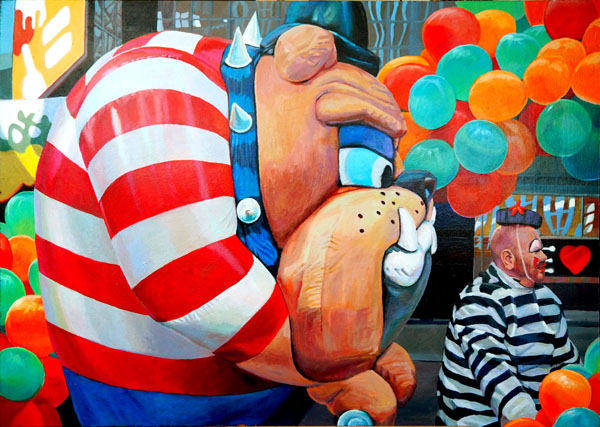Zooming In on the Use of Photographs
James A. Metcalfe, Watercolor Magazine
In the late 19th century, many people believed that the growing popularity of photography signaled the demise of painting. While photographers proliferated, artists continued to paint, however. Ironically, the camera has since become a very important tool for the artist.

The French photographer Eugene Atget felt that a photograph was not an identical copy of it’s subject, but rather, and interpretation of it. Many artists today would agree. Photography is a subjective medium. The camera’s eye and the human eye don’t see reality the same way. Some painters reject the camera, saying it is a hinderance to their creativity. Others, however, regard the camera as a valuable reference tool…
Cincinnati artist Paul Rienzo believes that “art must tell a story.” A student of Gestalt psychology, anthropology, and such illustrators as Norman Rockwell and Joseph Leyendecker, Rienzo uses rich color, powerful composition, and remarkable figurative realism to draw the viewer into the psychic narrative of his paintings. Many of his acrylic works center on Venice Beach, California, where people gather on the boardwalk just to enjoy the ambience of the crowd itself. His paintings are subtle, social statements regarding the loss of innocence in American life.

“My compositions have a photographic quality, notable in the way the look ‘cropped.” I want the viewer to imagine there is more happening outside the frame in the same way a photograph represents only a fraction of an event,” Rienzo says. “At times, it is better to end a painting at a person’s torso rather than include a face that would divert the viewers attention from what you want him or her to see.”
A self-taught artist (he holds a degree in chemical engineering from Worcester Polytechnic Institute in Massachusetts), Rienzo believes that the success of any painting primarily lies in it’s ability to stimulate, to provoke an interpretation or reaction.” Realism has an incredible potential for provoking such viewer reaction, he says, and the camera is the ideal tool for recording it. He engages the viewer by painting figures in action rather that static objects.
The artist says there are numerous advantages to using photographs as a springboard for his works. “Not only do photos freeze moments in time, stopping motion and light but they also allow me to paint subjects that I couldn’t do otherwise – you really can’t set up an easel in the middle of a busy crowd,” he says. Furthermore, he can draw scenes with precision. Most significantly, a photo allows him to capture people as they are – their natural expressions and gestures. The artist becomes omnipresent, a witness to everything happening in the scene.
“Although I want my work to give the illusion of great accuracy, the painting is always quite different from the photograph,” he says. After all, if I could capture a perfect image in one snapshot, I wouldn’t need to paint it.” During the actual painting process, Rienzo notes, “I simplify to work by removing details like clothing patterns or blemishes to create just a few textures. I then clarify the piece by making lines and forms more pronounced – removing out-of-focus fuzziness – and adding detail where it may be washed out or overshadowed. Additionally, I might use bolder colors (such as cobalts or cadmiums) for emphasis, repeat colors to unify the composition, and use ‘prismatic outlining’ (when objects and figures are subtly edged in complementary colors).

“I work very hard to replicate the light and shadow in a scene since I like the effects of bright sunlight,” he adds. He finds the sunlight often creates interesting abstract forms.
Rienzo usually used two or three photographs per piece, but for very small paintings he works from just one; for larger pieces he might refer to as many as 25. He says it’s important to use photos that have similar light and shadow characteristics.
When studying crowd scenes, Rienzo takes a number of shots from different viewpoints. He says, “the biggest drawback in producing Photo-Realist art is that the viewer often doesn’t recognize the artist’s creativity. I wish I could now them what I worked from because that would make the creativity quite clear.”